What Did Van Gogh Family Do With His Paintings
| Memory of the Garden at Etten | |
|---|---|
 | |
| Artist | Vincent van Gogh |
| Year | 1888 |
| Catalogue |
|
| Medium | Oil on canvas |
| Location | The Hermitage, St. Petersburg, Russian federation |
Van Gogh's family in his fine art refers to works that Vincent van Gogh made for or about Van Gogh family members. In 1881, Vincent drew a portrait of his grandpa, besides named Vincent van Gogh, and his sister Wil. While living in Nuenen, Vincent memorialized his father in Still Life with Bible following his death in 1885. In that location he likewise made many paintings and drawings in 1884 and 1885 of his parent'southward vicarage, its garden and the church. At the top of his career in Arles he made Portrait of the Artist's Female parent, Retentiveness of the Garden at Etten of his female parent and sister and Novel Reader, which is thought to be of his sister, Wil.
While van Gogh was at the Saint-Paul Asylum, Saint-Remy, he made several paintings as gifts for his mother and sister, and the painting Almond Blossoms for his blood brother Theo and his wife Johanna to gloat the birth of their son, whom they named Vincent.
Vincent van Gogh (grandpa) [edit]
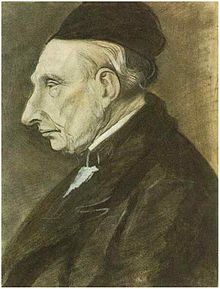
Vincent van Gogh, Portrait of Vincent van Gogh, the artist's grandfather, 1881, Van Gogh Museum, Amsterdam
Vincent van Gogh's grandfather (born 1789) was also named Vincent van Gogh. Co-ordinate to the artist's first biographer, his sis-in-law Johanna van Gogh, the grandfather was a pastor, and the son of Johanna van der Vin of Malines and Johannes van Gogh. Johanna van Gogh writes that Johannes "was at outset a gilded-wire drawer like his male parent, but he later became a Bible teacher and a clerk in the Cloister Church at The Hague." She describes him as an intellectual, duty-bound man who was awarded prizes and testimonials for his distinguished work.[1] A family legacy, from his great-uncle—a sculptor and a lifelong bachelor—allowed Vincent van Gogh (the elder) to study divinity at the University of Leiden. After successfully completing his studies and having become established at the parsonage of Benschop, he married E. H. Vrydag in 1810.[ane] They remained married until Elisabeth's death on vii March 1857; the Reverend Vincent van Gogh lived until 1874.[2]
In July 1881, Vincent (the younger) made Portrait of Artist'southward Grandfather (F876). The work was fatigued in pencil and brownish ink, with opaque white watercolor and a brown wash. The drawing is owned by the Van Gogh Museum in Amsterdam.[three]
Male parent and mother [edit]
Theodorus van Gogh [edit]
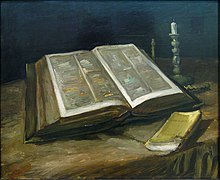
Theodorus van Gogh was born 8 February 1822, one of eleven children and the only one of six brothers to become a pastor like his father. Theodorus graduated from Utrecht in 1849 later successfully completing his theology programme, which allowed him to secure a position every bit pastor in Groot-Zundert, a village in the North Brabant region of the Netherlands. He was confirmed by his father, Vincent van Gogh, in Zundert on 1 April 1849.[4] Reverend Theodorus van Gogh was pastor of the Protestant Dutch Reformed Church building, which adhered to Calvinist doctrine.[5] In May 1851, Theodorus married Anna Cornelia Carbentus, whose father was in the book concern. Co-ordinate to Johanna van Gogh, Theodorus was a handsome human, "he was called the handsome parson by some, he had an amiable character and fine spiritual qualities."[vi] Vincent van Gogh made a painting of his father's Dutch Authorized Bible in Withal Life with Bible (F117) months later on Theodorus' sudden death in March 1885. The Bible symbolizes his father'due south faith, which Vincent saw as mired in convention. He painted the page open to the passage of Isaiah 53. He placed Émile Zola's novel La Joie de vivre (English language: The Joy of Living) in forepart of the Bible which to him likely symbolized worldliness. The burned out candle shows an extinguishment—mayhap both of the begetter's life and of Vincent's organized religion.[seven]
Anna van Gogh [edit]
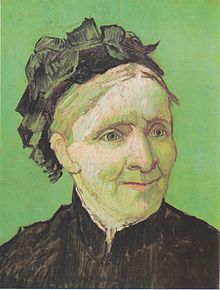
Portrait of Artist's Mother, October 1888, The Norton Simon Museum of Art, Pasadena, California (F477)
Anna Cornelia Carbentus was built-in 10 September 1819 at The Hague to Willem Carbentus, who was a royal bookbinder. Her younger sis Cornelia married Theodorus' brother, Vincent van Gogh, the fine art dealer, and her older sister married a clergyman named Stricker.[eight] Anna became a devout and helpful clergyman'south married woman, helping her husband in the parish.[8] She enjoyed art and was artistically inclined, "filling notebooks with drawings of plants and flowers"[9] and studied painting with Hendrik van de Sande Bakhuyzen. She outlived her three grown sons and her husband, yet still retained "her energy and spirit and bore her sorrow with rare courage."[viii]
Portrait of the Artist'south Mother (Van Gogh) (F477) was based upon a black-and-white photograph of his mother. Vincent's mother appears to be a respectable middle class woman, attentive and proud, against a green background.[x]
Van Gogh painted Memory of the Garden at Etten (F496) to hang in his bedroom. He envisioned the older woman was his mother and the younger in a plaid shawl his sister Wil. To Wil he said he had "an impression of yous like those in Dickens' novels." Wil stands behind her mother in the painting. Behind them is a woman aptitude over working the garden. Mother and daughter fill the foreground of the left motion-picture show frame, seemingly walking out of the scene.[xi] In a letter to his sis he described the painting:
"The younger of the two ladies who are out for a walk is wearing a Scottish shawl with greenish and orange checks, and a cherry-red parasol. The quondam lady has a violet shawl, most black. But a agglomeration of dahlias, some of them citron yellow, the others pinkish and white mixed, are like an explosion of color on the somber figure. Behind them a few cedar shrubs and emerald-dark-green cypresses. Behind the cypresses one sees a field of pale light-green and red cabbages, surrounded by a border of little white flowers. The sandy path is of a raw orange color; the foliage of the two beds of carmine geraniums is very dark-green. Finally, the interjacent plane, there is a maid-servant, dressed in blue, who is arranging a profusion of plants with white, pink, yellowish and vermilion-ruby-red flowers."
"Here yous are. I know this is hardly what i might call a likeness, only for me it renders the poetic character and the style of the garden equally I feel information technology. All the same, let us suppose that the two ladies out for a walk are you and our female parent; let us even suppose that there is not the least, admittedly not the least vulgar and fatuous resemblance – yet the deliberate choice of colour, the somber violet with the blotch of trigger-happy citron yellow of the dahlias, suggests Female parent's personality to me."
"The figure in the Scotch plaid with orange and green checks stands out against the somber light-green of the cypress, which contrast is further accentuated past the blood-red parasol – this figure gives me an impression of you similar those in Dickens's novels, a vaguely representative effigy."[12]
As he rose to the peak of his career, Vincent enjoyed passing on prized paintings to his family unit. "Great bouquets of flowers, violet-colored irises, keen bouquets of roses," went to his mother.[13] Another example, "the most resolved and stylized of the iii" paintings of women picking olives was made for his sister and mother.[14] [xv]
Family [edit]
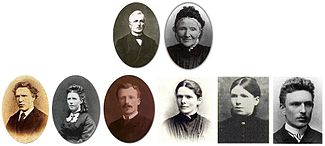
Theodorus and Anna van Gogh's family, including Vincent, Anna, Theo, Elizabeth, Wilhelmien and Cornelius
Anna and Theodorus were both devoted to the communities they served, ensuring their deeds spoke every bit resolutely as Theodorus' Lord's day sermons.[xvi] Both female parent and father believed that God e'er watched over them and encouraged their children to look for God'due south presence in nature, such as the shape of the clouds or in the many colors in the sunsets.[sixteen]
Vincent said in 1889, "Whatever I recall on other points, our begetter and mother were exemplary as married people."[17]
Vincent van Gogh [edit]
Vincent van Gogh was born on 30 March 1853, exactly one year after the stillborn delivery of Anna and Theodorus' starting time child who was named Vincent. As a kid, he liked animals and flowers. In temperament, he was strong, energetic and strong-willed. Vincent enjoyed playing outdoors and fabricated up games for his brothers and sisters, once rewarded with the most beautiful rose bush-league in the garden every bit his award. In that location were a few times that Vincent exhibited his artistic talent and upon receiving praise from his parents, he destroyed the items. He attended the local school just his interaction with the peasant boys was making him tough. Every bit the family grew, a governess was brought in to tutor the children at the vicarage.[eight]
In 1864, Vincent, aged eleven, was sent abroad for schooling to a nearby boarding school in Zevenbergen which led to his lifelong feelings of being an exile.[9] In 1866, his parents decided to send him to the new and prestigious Willem II College in Tilburg. In March 1868 Van Gogh suddenly returned home. During his 2 years at the Willem Two College the painter C.C. Huijsmans had been his art class instructor. As Van Gogh entered adulthood the divide widened. After failing every bit an art dealer and in the ministry building, he decided to become an artist. The more his family members suggested possible alternative vocations the greater the gulf between Vincent and his family. Further, Vincent's style of dress, behavior and unusual love life was unsettling and embarrassing to the family.[18] Past 1881 Vincent had adult his personal view of the world and religion which was very different from his parents', finding organized organized religion too constrictive. He wrote to his brother, Theo, "I discover Begetter and Mother's sermons and ideas about God, people, morality and virtue a lot of stuff and nonsense."[xix]
-

Self-Portrait with Grey Felt Lid, March/April 1887, Oil on pasteboard, 19 × 14 cm, Van Gogh Museum, Amsterdam (F296)
-

Cocky-Portrait with Straw Hat, Summer 1887, Oil on pasteboard, 24.9 × 26.7 cm, Detroit Institute of Arts (F526)
Theo van Gogh [edit]
Theo van Gogh (art dealer) was born in Groot Zundert on ane May 1857, four years afterward his brother Vincent.[20] He was more tender, kind and delicately congenital merely shared his older brother's ruby fair complexion and low-cal blue eyes.[8] Theo and Vincent began writing messages to ane another in 1872 and continued for xviii years, with 668 letters from Vincent to Theo, many of them with sketches. Theo became Vincent's primal source of emotional and financial support as he pursued his artistic development. Theo, who managed an art gallery in Paris and was knowledgeable of trends in modern art, offered Vincent advice. Theo married Johanna Bonger and had a son, whom they named Vincent. Theo died six months after Vincent's death on 25 January 1891.[20]
-

Photograph of Theo van Gogh, 1888
-

Photo of Theo van Gogh, 1890
-

The Van Gogh Museum attributes a painting generally considered a self-portrait to actually be a portrayal of his brother, Theo. In Portrait of Theo van Gogh, (F294), the museum says that the painting was made "to experiment with colour, as we tin can see in the effect of the yellow hat against the blue background, and the range of colors in the jacket, bow-tie and background."[21] Albert J. Lubin, author of "Stranger on the Earth: A Psychological Biography of Vincent van Gogh" claims that Vincent made no portraits of his brother.[22]
Next to this painting is one of Vincent's self-portraits (F296), besides fabricated in 1887.
-

Named by VGM, Portrait of Theo van Gogh, 1887
Van Gogh Museum, Amsterdam (F294)[21] -

Cocky-Portrait with Grey Felt Hat, March/April 1887
Oil on pasteboard, 19 × fourteen cm
Van Gogh Museum, Amsterdam (F296)
Vincent made Almond Blossoms for Theo and his wife to celebrate the birth of their son, symbolizing new life in the flowers of the almond tree.[23] Vincent wrote to his female parent of the nascence of Theo and Jo's babe,
"How glad I was when the news came... I should take greatly preferred him to telephone call the boy later on Father, of whom I have been thinking so much these days, instead of later on me; but seeing it has now been washed, I started right away to make a picture for him, to hang in their bedchamber, large branches of white almond flower confronting a blue sky."[24]
The bright color is reflective of the paintings made in Arles and the transformational work Vincent had on the still life genre.[25]
Wil van Gogh [edit]
Wil, short for Wilhelmein, was the youngest of Vincent's sisters, built-in in 1862. She lived with her parents, and after her begetter died, stayed on with her mother. At times she was a governess, private nurse, social worker and religion teacher. She longed to exist a writer and was enthusiastic to hear of news about Paris, its art and cultural happenings. Van Gogh and Wil wrote to each other nigh literature and modern art in much the aforementioned way he did with his blood brother, Émile Bernard and Paul Gauguin.[26]
Novel Reader is evocative of Vincent'south sister.[11] He describes it in a alphabetic character to Wil, "'Une Liseuse de Romans', the luxuriant hair very black, a green bodice, the sleeves the colour of vino lees, the skirt black, the background all yellow, bookshelves with books. She is holding a yellow book in her easily."[12] The painting was made immediately later Vincent completed a "fantasy" painting of his female parent and Wil, Memory of the Garden at Etten.[xi]
-

Photograph of Wilhemein "Wil" van Gogh
-
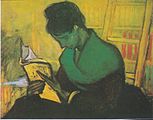
The Novel Reader, 1888, Private collection (F497)
Vincent made a cartoon of his sis, "Portrait of Willemina Jacoba ('Willemien') van Gogh" (F849) in July 1881 with pencil and charcoal. It is endemic past the Kroller-Muller Museum, Otterlo, Netherlands.[27] The work is besides said to be a "possible" portrait of Wil.[28]
In 1888 he gave two paintings to Wil for her birthday. One was Blossoming Almond Branch in a Glass with a Book, which he described to her in a letter as "a little report of a book for you." The 2d, Withal Life with French Novels and a Rose, "on a somewhat larger scale, a bloom, with a lot of books with pink, light-green and bright red bindings – they were my set up of 7 Parisian novels."[29]
During the summer of 1889, honoring his sister Wil'due south request, Vincent made several smaller versions of Wheat Field with Cypresses.[30]
-

Blossoming Almond Co-operative in a Glass with a Book, 1888, Private collection (F393)
-

Still Life with Piles of French Novels and a Drinking glass with a Rose (Romans Parisiens), 1887, Private Collection, Switzerland (F359)
Anna, Elizabeth and Cornelius [edit]
Vincent did not take a close human relationship with Elizabeth or Cornelius his youngest brother.[ citation needed ]
Anna lived with Vincent in London for a menses in 1874-5. Their initially warm human relationship became strained; in April 1875, Anna wrote about Vincent'southward behaviour to Theo: "I believe that he has illusions near people and judges people before he knows them, and so when he finds out what they're really similar and they don't live up to the stance he formed of them prematurely, he'due south then disappointed that he throws them away like a boutonniere of wilted flowers, without looking to come across whether or non in that location are some among those wilted flowers which, when handled with care, are not quite rubbish yet."[31] She married Joan Marius van Houten in August 1878. Vincent attended the ceremonies, just relations with his sis remained cool; Anna complained about his aloofness and characterized him every bit a "wooden king of beasts"[32] After their father's death in 1885 the two became estranged.
Anton Mauve [edit]
Anton Mauve was married to Vincent's cousin Ariëtte (Jet) Sophia Jeannette Carbentus[33] and was a major influence on the artist. He is mentioned directly in 152 of Vincent's surviving messages. Vincent spent three weeks at Mauve'southward studio at the end of 1881 and during that time he made his first experiments in painting under Mauve's tutelage, starting time in oils and and so early the adjacent yr in watercolour (previously he had concentrated on cartoon). Mauve continued to encourage him and lent him coin to rent and furnish a studio[34] simply later on grew common cold towards him and did non return a number of letters.[35]
In a letter of the alphabet to his brother Theo dated seven May 1882,[36] Vincent describes "a very regrettable chat" in which Mauve told him their association was "over and done with" adding past style of explanation that Van Gogh had a vicious grapheme. Vincent connected his letter by expressing his sorrow and and then defiantly launches into a defense of his human relationship with Clasina (Sien) Maria Hoornik, a pregnant prostitute he had befriended.
Vicarage and church [edit]
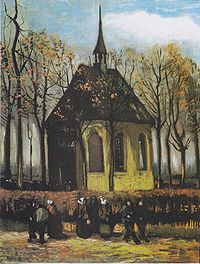
In 1882 Vincent'south father became pastor in Nuenen situated in the North Brabant province of the Netherlands. Having been in Drenthe for several months, Vincent came to live with his parents in December 1883 and stayed in that location until May 1885. The laundry room at the dorsum of the house was turned into a studio for him. Theo's father wrote to him: "Nosotros do not call up information technology'due south really suitable, but we have had a proper stove installed... I wanted to put in a large window too, merely he prefers not to accept one."[37]
A simple ii-story rock building, the parsonage sat on the main street of Nuenen. The second story provided Vincent beautiful views, including a church belfry in the distance. The laundry room became his studio. Vincent recorded the changing seasons in his paintings of the garden, which was enclosed by a high stone wall and included a duck pond with a boat dock, paths and hedges, flower and vegetable garden plots and an orchard.[38]
-

The Vicarage at Nuenen in the Moonlight, Nov 1885, Private drove (F183)
Congregation Leaving the Reformed Church in Nuenen (F25) was made early 1884 for his parents, his male parent the pastor of the church building since 1882. Vincent's mother, Anna van Gogh, was healing from a broken thighbone.[39] Vincent wrote to his blood brother, "Taking her difficult state of affairs into consideration, I am glad to say Female parent's spirits are very fifty-fifty and bright. And she is tickled past trifles. The other day I painted for her a little church with the hedge and the copse." The alphabetic character included a sketch with i person in front of the church,[40] a peasant with a spade. X-rays of the painting betoken that Vincent later added church members and autumn leaves to the previously bare trees, which fabricated the work more colorful. The changes were not likely made before the fall of 1885. Vincent may accept added the adult female in mourning and congregation members for his female parent equally a memorial for his begetter's decease. The painting was stolen from the Van Gogh Museum on seven Dec 2002.[39] The painting was recovered in Naples, Italy in September 2016.[41]
The Rectory Garden in Nuenen in the Snow (F194) depicts a worker shoveling a path in the snow of the Vincent's garden. The winter scene of blank-branched trees and gloomy sky hints of the preceding fall by a few remaining red leaves. Vincent wrote to Theo: "The life and expiry of peasants remain forever the same, withering regularly, like the grass and flowers growing in that churchyard." The Norton Simon Museum reports that X-ray of the painting shows that underneath this painting is a painting of a woman at her spinning wheel.[42]
-

The Rectory Garden in Nuenen in the Snow, January 1885, Norton Simon Museum, Pasadena (F194)
-

The Rectory Garden in Nuenen in the Snow, January 1885, Armand Hammer Museum of Art, Los Angeles (F67)
-

The Parsonage Garden at Nuenen with Pond and Figures, watercolor, November 1885, Private collection (F1234)
-

The Parsonage Garden at Nuenen with Pond and Figures, 1885, Destroyed past burn in Earth War Two, Rotterdam (F124)
References [edit]
Citations [edit]
- ^ a b Johanna Gesina van Gogh – Bonger, Vincent's sister in police force (2011). "Memoir of Vincent van Gogh". Van Gogh Paintings. Van Gogh Gallery. Retrieved 17 May 2011.
- ^ Hulsker, 6
- ^ "Portrait of Vincent van Gogh, the Artist'southward Grandfather". Van Gogh Paintings. Van Gogh Gallery. 2011. Retrieved 17 May 2011.
- ^ Hulsker, 6, 8
- ^ "Dutch Reformed Church". Permanent Collection. Van Gogh Museum. 2005–2011. Archived from the original on 3 February 2014.
- ^ qtd in Hulsker, 6
- ^ "Symbolism". Permanent Collection. Van Gogh Museum. 2005–2011. Retrieved 15 May 2011' Come across more than to tell
{{cite web}}: CS1 maint: postscript (link) - ^ a b c d e Johanna Gesina van Gogh – Bonger, Vincent's sister in law (2011). "Memoir of Vincent van Gogh, page ii". Van Gogh Paintings. Van Gogh Gallery. Retrieved 17 May 2011.
- ^ a b Greenberg, J; Jordan, South (2001). Vincent Van Gogh: Portrait of an Creative person. New York: Delcorte Press. p. PT10. ISBN978-0-307-54874-0.
- ^ "Portrait of the Artist'south Mother, October 1888". Collection. Norton Simon Museum of Fine art. 2002–2011. Retrieved eleven May 2011.
- ^ a b c Zemel, C (1997). Van Gogh's Progress: Utopia, Modernity, and Late-Nineteenth-Century Art. Berkeley: University of California Press. p. 128. ISBN0-520-08849-2.
- ^ a b Harrison, R, ed. (2011). "Vincent van Gogh. Letter to Wilhelmina van Gogh. Written c. 16 November 1888 in Arles". Van Gogh Letters. WebExhibits. Retrieved 17 May 2011.
- ^ Mancoff, D (1999). Van Gogh: Fields and Flowers . San Francisco: Chronicle Books. pp. 23, 28. ISBN0-8118-2569-8.
- ^ "Women Picking Olives". Drove. The Metropolitan Museum of Art. 2000–2011. Retrieved 25 March 2011.
- ^ Leeuw, R (1997) [1996]. van Crimpen, H; Berends-Albert, G (eds.). The Letters of Vincent van Gogh. London and other locations: Penguin Books.
- ^ a b Silverman, D (2000). Van Gogh and Gauguin: The Search for Sacred Fine art. New York: Farrar, Straus and Giroux. pp. 147–148. ISBN0-374-28243-nine.
- ^ Harrison, R, ed. (2011). "Letter of the alphabet from Vincent van Gogh to Theo van Gogh, Arles, 22 or 23 January 1889". Van Gogh Letters. WebExhibits. Retrieved 16 May 2011.
- ^ Gayford, M (2008) [2006]. The Yellowish House: Van Gogh, Gauguin, and Nine Turbulent Weeks in Provence. Mariner Books. pp. 124–127. ISBN978-0-618-99058-0.
- ^ Harrison, R, ed. (2011). "Letter from Vincent van Gogh to Theo van Gogh, Etten, c. 21 Dec 1881". Van Gogh Letters. WebExhibits. Retrieved 11 May 2011.
- ^ a b Crispino, E (2008). Van Gogh . Minneapolis: The Oliver Press. p. 20.
- ^ a b "Portrait of Theo van Gogh, 1887". Permanent Collection. Van Gogh Museum. 2005–2011. Retrieved 17 May 2011.
- ^ Lubin, A (1996) [1972]. Stranger on the Earth: A Psychological Biography of Vincent van Gogh. New York: Da Capo Printing. p. 236. ISBN0-306-80726-two.
- ^ "Almond Blossom, 1890". Permanent Drove. Van Gogh Museum. 2005–2011. Retrieved 23 April 2011.
- ^ Harrison, R, ed. (2011). "Vincent van Gogh. Letter to His Mother. Written c. 20 February 1890 in Saint-Rémy". Van Gogh Letters. WebExhibits. Retrieved 23 Apr 2011.
- ^ Ross, B (208). Venturing Upon Dizzy Heights: Lectures and Essays on Philosophy, Literature and the Arts. New York: Peter Lang Publishing. p. 52.
- ^ Zemel, C (1997). Van Gogh'due south Progress: Utopia, Modernity, and Tardily-Nineteenth-Century Fine art. Berkeley: University of California Press. pp. 125–126. ISBN0-520-08849-2.
- ^ "Portrait of Willemina Jacoba ('Willemien') van Gogh". Collection. Kroller-Muller Museum. Retrieved 17 May 2011.
- ^ "Portrait possibly of Willemien van Gogh". Van Gogh Paintings. Van Gogh Gallery. 2011. Retrieved 17 May 2011.
- ^ Harrison, R, ed. (2011). "Vincent van Gogh. Letter to Wilhelmina van Gogh. Written 30 March 1888 in Arles". Van Gogh Messages. WebExhibits. Retrieved 17 May 2011.
- ^ Ronald Pickvance, Van Gogh In Saint-Remy and Auvers. 132–133. Exhibition catalog. Metropolitan Museum of Art, 1986. ISBN 0-87099-477-viii
- ^ Alphabetic character 33 Notes
- ^ Letter 147 Notes. vangoghletters.org
- ^ Family tree of Vincent Van Gogh. vangoghletters.org
- ^ "Letter of the alphabet 196". Vincent van Gogh. The Letters. Amsterdam: Van Gogh Museum.
- ^ Tralbaut (1981), 96–103
- ^ "Letter of the alphabet 224". Vincent van Gogh. The Letters. Amsterdam: Van Gogh Museum.
- ^ "The Vicarage at Nuenen, 1885". Permanent Collection. Van Gogh Museum. 2005–2011. Retrieved fifteen May 2011.
- ^ Fell, D. (2004). Van Gogh'southward Women: His Love Diplomacy and Journey Into Madness. Carroll & Graf. ISBN978-0-7867-1425-4 . Retrieved 31 March 2020.
- ^ a b "Congregation Leaving the Reformed Church in Nuenen, 1884". Permanent Drove. Van Gogh Museum. 2005–2011. Retrieved fifteen May 2011.
- ^ "Vincent van Gogh. Letter to Theo van Gogh. Written c. 24 January 1884 in Nuenen". Van Gogh Paintings. Van Gogh Gallery. 2011. Retrieved 17 May 2011.
- ^ "Twee gestolen schilderijen Van Gogh na veertien jaar teruggevonden" (in Dutch), de Volkskrant, 2016. Retrieved 30 September 2016.
- ^ "Wintertime (The Vicarage Garden nether Snow)". Collections. Norton Simon Museum. 2002–2011. Retrieved 19 May 2011.
Sources [edit]
- Crispino, E (2008). Van Gogh. Minneapolis: The Oliver Press.
- Roughshod, D (2005) [2004]. Van Gogh's Women: Vincent'due south Beloved Affairs and Journey Into Madness. New York: Carroll and Graf Publishers. p. 56. ISBN 0-7432-0233-iii.
- Hulsker, Jan. Vincent and Theo van Gogh; A dual biography. Ann Arbor: Fuller Publications, 1990. ISBN 0-940537-05-2.
- Gayford, One thousand (2008) [2006]. The Xanthous House: Van Gogh, Gauguin, and Ix Turbulent Weeks in Provence. Mariner Books. ISBN 978-0-618-99058-0.
- Greenberg, J; Hashemite kingdom of jordan, South (2001). Vincent van Gogh: Portrait of an Artist. New York: Delcorte Press. ISBN 978-0-307-54874-0.
- Leeuw, R (1997) [1996]. van Crimpen, H, Berends-Albert, M. ed. The Letters of Vincent van Gogh. London and other locations: Penguin Books.
- Lubin, A (1996) [1972]. Stranger on the World: A Psychological Biography of Vincent van Gogh. New York: Da Capo Press. ISBN 0-306-80726-2.
- Mancoff, D (1999). Van Gogh: Fields and Flowers. San Francisco: Chronicle Books. ISBN 0-8118-2569-eight.
- Silverman, D (2000). Van Gogh and Gauguin: The Search for Sacred Art. New York: Farrar, Straus and Giroux. ISBN 0-374-28243-nine.
- Zemel, C (1997). Van Gogh'southward Progress: Utopia, Modernity, and Late-Nineteenth-Century Art. Berkeley: Academy of California Press. ISBN 0-520-08849-2.
Source: https://en.wikipedia.org/wiki/Van_Gogh%27s_family_in_his_art
0 Response to "What Did Van Gogh Family Do With His Paintings"
Post a Comment